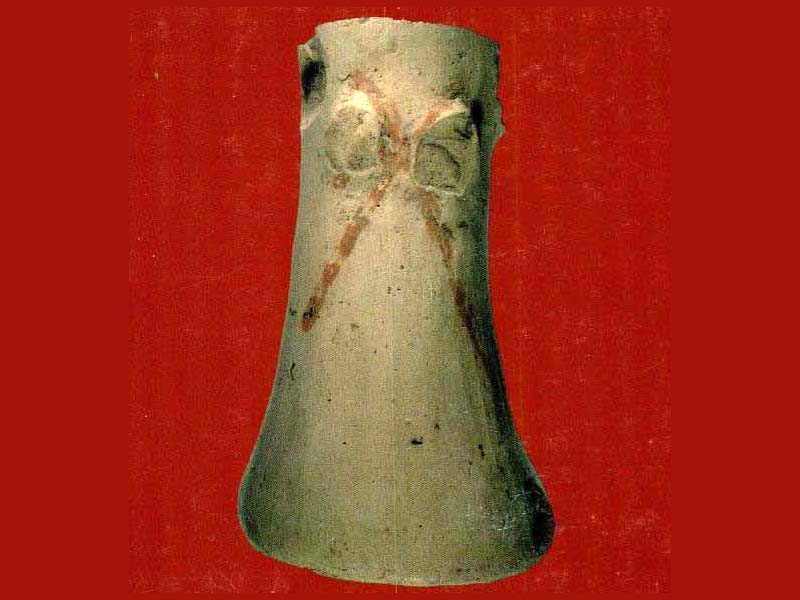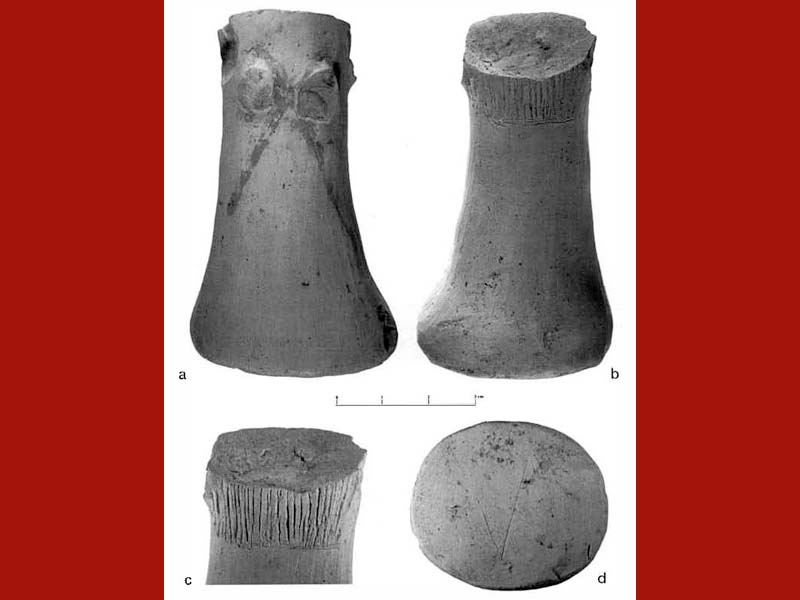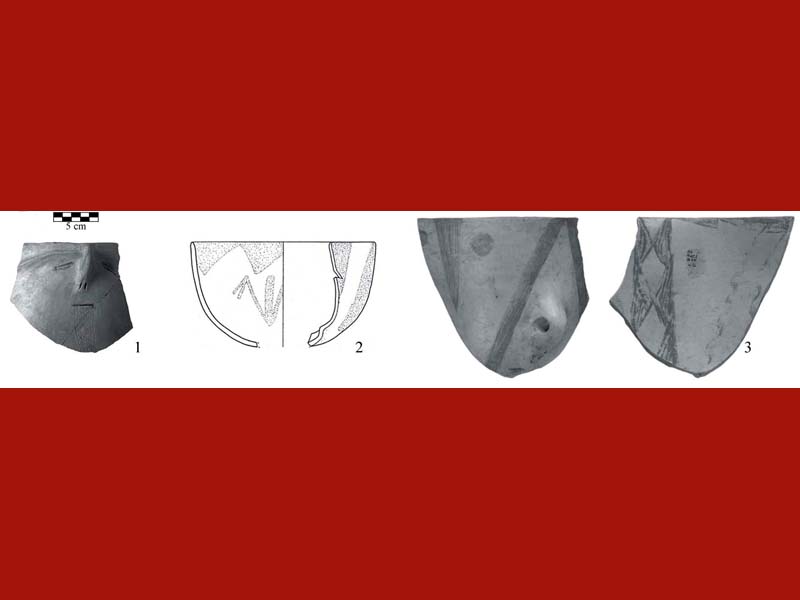Cylindrical statuette, made of light beige purified dough, without arms. “… The breasts, mutilated, are marked by two lines painted in ocher that cross in an X in the center of the chest and continue on the body, which retains other traces of ocher in its anterior part. The foot is expanded ellipsoidal: this expansion is more accentuated in the rear part. The base of the foot bears a subtly engraved V sign. The surfaces are well preserved: the traces of modeling are evident in the form of thin parallel spatula strokes ...” (C. Tozzi and B. Zamagni, 2001). It is considered of some importance due to the rarity with which objects of this type are found in central Italy. “… Four fragments, identical in size and mixture, can be traced back to the same typology…” (M. Colombo, 2012)
This figurine is quite different from what was found in the southern painted pottery areas, the form is in fact "… distinctly cylindrical (truncated – conical) and not flat or flat-convex as in the statuettes of Raven Pass ...” (MA Fugazzola, Delpino, 2002-2003).
The most immediate comparison is with the figurines of Ripabianca of Monterano (Marches), that of Pavolella cave (Calabria) and that of Sammardenchia (Friuli) which indicates close relations even between areas that are not very close. As for the origin of this type of representation "… we must undoubtedly turn to the Neolithic cultures of the Balkan area, especially that of Vinca (Bagolini 1978). Also in this culture, in fact, the figurines have the same stylized body, rendered with a cylinder with an expanded base, and also bear V-shaped signs painted in red; however, there is no lack of Anatolian influences, especially as regards the X sign on the chest (Gimbutas 1990) …” (C. Tozzi and B. Zamagni, 2001).
To date, 31 finds have been found in the sites of the Culture of Catignano, of which the indicated statuette is the most complete: eighteen fragments of statuettes, three fragments of vases with human protomes, eight zoomorphic vases, an idol with an animal shape and a probable croissant.
Regarding the fragments, as in other Neolithic sites, fractures of the figurines have been observed which would appear to be ritual and not due to accidents or casual breakages but on which there is still no significant interpretation. Mostly the clay idols were found in domestic contexts and it makes us think that they must have been created and destined for personal and family cults; “… the discovery of some figurines in the same mixture of the plastered walls and with a completely flat side suggest the existence of a structure with a plastered wall decorated with applied plastic figurines …” (R. Grifoni Cremonesi and A. Pedrotti, 2012) confirms the construction of domestic spaces dedicated to cult images.
Regarding the variety in the representation of female idols, moreover, more than evidence of a single fertility goddess or mother goddess "… it seems rather evidence of a highly articulated ideological heritage in which the female figure was covered with several distinct meanings …” (M. Colombo, 2012). Even in the Culture of Catignano - as noted for the culture of Ripoli – the fact that the models of several statuettes are very similar to those found in the Middle East and Anatolia "… suggests that the spiritual ideological orientation in this first phase was based on a supra-regional communication system shared by the painted pottery groups … the presence in the contexts of evolved Adriatic Impressa Ceramics, Catignano and the Early Alpine Po Neolithic of some elements in common – cylindrical statuettes with an enlarged base and tongue arms – of Balkan origin confirms the existence of contacts between these areas which has been repeatedly hypothesized on the basis of the analysis of the pottery …” (R. Grifoni Cremonesi and A. Pedrotti, 2012).
Among the zoomorphic vases, the most intact is a painted figulina ceramic vase which presumably depicts a small pig, the animal sacred to the pregnant goddess, "…whose round, fast-growing body was believed to personify fertility. Images of sows have been found at various sites and demonstrate that the animal depicted in Old European sculptural art was an epiphany of the Goddess…” (M. Gimbutas, 2008). The finds of zoomorphic vases are particularly interesting because it is a rather rare typology in Italian Neolithic sites, while the croissants refer to another symbology, not very recurrent in Italy at the moment, linked to the depiction of the bull.





Historical notes
The archaeological site of Catignano has been the object of in-depth research by the Department of Archaeological Sciences of the University of Pisa together with the Archaeological Superintendency of Abruzzo, making the enormous archaeological interest immediately evident; traces of different periods have emerged on the site, from a Gravettian lithic workshop dated to about 25.000-20.000 years ago, up to the actual Neolithic village, with numerous finds in an exceptional state of conservation. Excavations began in the 70s, with the discovery of numerous structures distributed according to a primitive urban concept, with primitive ovens, huts and round or ellipsoidal holes. The population's economy was based on agriculture and livestock breeding; the abundance of obsidian demonstrates the existence of an active trade with the Tyrrhenian coast. The figurine was found during excavations in 2000.
CARD
LATEST PUBLISHED TEXTS
VISIT THE FACTSHEETS BY OBJECT

